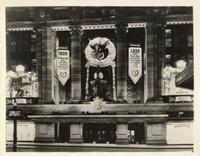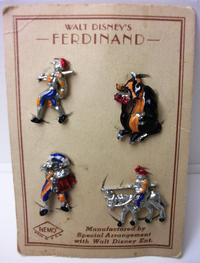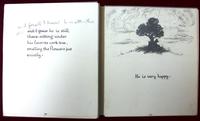With 2011 coming to an end, we want to recognize the 75th anniversary of one of our favorite children’s books: Munro Leaf and Robert Lawson’s The Story of Ferdinand. Published by Viking Press in 1936, the book has been translated into more than 60 languages (including Latin!) and the rights have recently been acquired by Fox Animation Studios, who plan to make a full-length animated film. Of course, we’re partial to The Story of Ferdinand here at the Free Library since we are lucky to have the papers of both author Munro Leaf and illustrator Robert Lawson in our Rare Book Department. The Munro Leaf papers were donated by his wife Margaret Leaf in 1977-1983 and the Frederick R. Gardner collection of Robert Lawson was donated by the avid collector Gardner in 1969-1977. Both collections are the largest source of materials for both Lawson and Leaf, and thanks to a CLIR-funded “Hidden Collections” grant, we were able to process these amazing materials and make them available to researchers.
Munro Leaf wrote The Story of Ferdinand for his friend Robert Lawson. Lawson had already received some recognition for his children’s book illustrations, but complained about the lack of artistic freedom inherent in illustrating other authors’ books. Ferdinand was to be a showcase for his incredible talent with pen and ink. One of the most popular items in the Munro Leaf papers is the original handwritten manuscript Leaf claimed to have dashed off in twenty minutes. While the book was an immediate hit in September 1936, it was not without controversy. Coincidentally published in the early days of the Spanish Civil War, the story about the Spanish bull who would rather smell the flowers than fight was interpreted by some as a pacifist fable. More elaborately, letters to Leaf accused him of “the laissez-faire theory of economics seconded by the bourgeois ideology of utility,” “Red propaganda,” and “Fascist propaganda” (New York Times November 20, 1937). Leaf had a simpler motive: “It’s a happy-ending story, about being yourself” (Washington Post June 25, 1967). As time passed and Ferdinand became a permanent part of the culture, the controversy wasn’t the only thing to fade. In 1968, a friend sent Leaf a clipping from the Washington Post which recommended buying The Story of Ferdinand at Brentano’s Book Store, which had “a version by Munro Leaf” (December 17, 1968).
While we are excited to see what Fox Animation Studios produces, it will not be Ferdinand’s first time on film. In 1938, Walt Disney Productions released the short film “Ferdinand the Bull” (you can find it on YouTube) which won the Academy Award for Best Short Subject (Cartoon) the following year. Unsurprisingly, the film release included a diverse array of merchandising opportunities for Ferdinand. Among the Walt Disney Enterprises ephemera in our collection, there is a Ferdinand pencil sharpener, fabric swatches, a charm bracelet, and some adorable decorative buttons memorializing Ferdinand and the unfortunate bullfighters. We also have two original painted animation cels from the Disney film which really put into perspective the enormous undertaking of a classically-animated film, even one only seven minutes long.
Disney may have been the highest-profile adapter of The Story of Ferdinand, but it was hardly alone. Our favorite unexpected adaptation is the program from “The Ballad of Ferdinan’: A Folk Rock Opera” from 1972. For slightly more historical interest, we also have a number of materials, including photographs and the script, from the 1939 marionette play adaption done by the WPA Federal Theatre Project. Another puppet-related highlight is the Puppet Theatre of Ljubljana’s “Zgodba o Ferdinandu” (produced in 1978), and while Slovene fluency would be helpful to anyone reading the program, the photographs require no translation.
We can’t help but get carried away with all of the exciting Ferdinand materials here at the Free Library, and we hope you’ll check out our Facebook page for updates or make an appointment to come visit the collections at the Rare Book Department. We’d be remiss not to mention one last masterpiece: the dummy of The Story of Ferdinand, made by Robert Lawson in 1935. The dummy, which is a mockup of the future book, includes the full text and elaborate graphite sketches that Leaf and Lawson used when shopping the story to various publishers. In fact, the copyright page credits “So-and-So Press,” waiting for the lucky publisher to recognize a masterpiece. While the dummy includes some corrections to the text, it is no surprise that the end remains unchanged: “He is very happy.”
-Caitlin Goodman
Have a question for Free Library staff? Please submit it to our Ask a Librarian page and receive a response within two business days.



